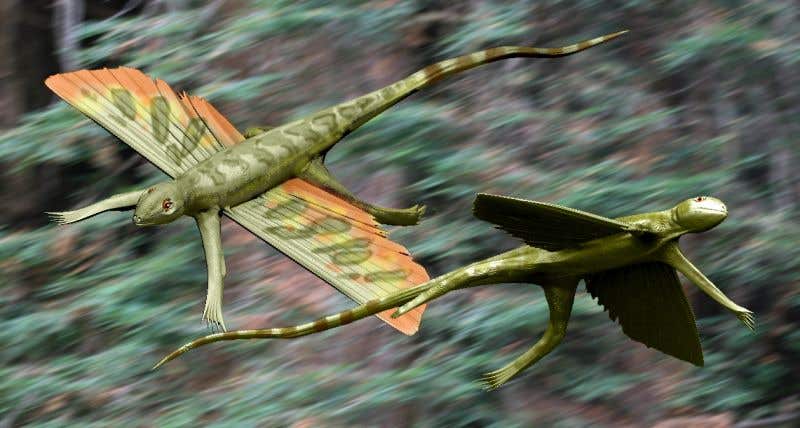Student discovers an incredible 200-million-year-old flying reptile
A Masters student unveiled an exciting find that introduces us to a lesser-known creature from prehistoric times – the Kuehneosaurs.

In the world of paleontology, discoveries are often celebrated for their ability to shed light on the distant past. Recently, a group of researchers at the University of Bristol unveiled an exciting find that introduces us to a lesser-known creature from prehistoric times - the Kuehneosaurs.
These remarkable creatures, resembling small lizards, actually share a closer genetic connection with the ancestors of crocodiles and dinosaurs.
Fossils of two distinct species of Kuehneosaurs were discovered, one featuring extensive wings, and the other with shorter wings formed from a layer of skin stretched over their elongated side ribs. These unique wings allowed them to gracefully swoop from tree to tree, displaying remarkable aerial agility.
Much like the modern-day flying lizard Draco found in southeast Asia, these ancient Kuehneosaurs are believed to have spent their time both on the ground and in the treetops, hunting insects. Their hunting strategy involved patiently waiting for potential prey or launching themselves into the air when they spotted an appetizing insect in flight, able to land safely up to 10 meters away from their starting point.
The fascinating discovery was made by Mike Cawthorne, a Masters student at the University of Bristol, while researching reptile fossils from limestone quarries. These quarries were situated on the Mendip Palaeo-island, which was the largest sub-tropical island of its time. Mr. Cawthorne's findings were published in a recent issue of Proceedings of the Geologists' Association.
Besides the Kuehneosaurs, the study also documented the presence of other intriguing reptile species in the region, including the trilophosaur Variodens and the aquatic Pachystropheus. The latter is thought to have lived a lifestyle akin to modern-day otters, likely subsisting on a diet of shrimps and small fish.
Related Stories
These reptiles, like the Kuehneosaurs, either met their fate by falling into caves or were carried into cracks within the limestone by the natural forces of erosion. Reflecting on his findings, Mike Cawthorne expressed his expectations, stating, "All the beasts were small. I had hoped to find some dinosaur bones, or even their isolated teeth, but in fact, I found everything else but dinosaurs."
These collections of fossils date back to the 1940s and 1950s when the quarries were still active, allowing paleontologists to directly observe fresh rock faces and consult with quarry workers.
Professor Mike Benton, a renowned expert from Bristol's School of Earth Sciences, explained the painstaking process of identifying the fossil bones, most of which were found in isolation rather than as part of a complete skeleton. Nevertheless, by comparing these isolated jaws and other bones with more complete specimens from other locations around Bristol, Mike Cawthorne was able to piece together the puzzle of the Mendip Palaeo-island's prehistoric ecosystem.
Professor Benton also emphasized, "He didn't find any dinosaur bones, but it's likely that they were there because we have found dinosaur bones in other locations of the same geological age around Bristol." This implies that the search for evidence of dinosaurs on the Mendip Palaeo-island is far from over.
The Mendip Palaeo-island, which stretched from Frome in the east to Weston-super-Mare in the west, spanned nearly 30 kilometers and was an ecological hotspot during the Late Triassic period, around 200 million years ago. This archipelago of small islands was situated in a warm sub-tropical sea, providing a diverse habitat for various species of small reptiles, including the Kuehneosaurs.
Dr. David Whiteside of Bristol added, "The bones were collected by some great fossil finders in the 1940s and 1950s, including Tom Fry, an amateur collector working for Bristol University." Mr. Fry's dedication to his craft involved cycling to quarries and returning with heavy bags of rocks, contributing immensely to our understanding of prehistoric life.
Other collectors who played a pivotal role in these discoveries included Walter Kühne, a German researcher who was held captive in Great Britain during World War II, and Pamela L. Robinson from University College London. Their specimens have become part of the Natural History Museum in London and the Geological collections of the University of Bristol, continuing to inspire new generations of paleontologists.
The Mendip Palaeo-island continues to unveil its secrets, offering a window into a world long past and raising intriguing questions about the ancient life that once thrived in this sub-tropical paradise.
The scientific paper can be found at: "Latest Triassic terrestrial microvertebrate assemblages from caves on the Mendip palaeoisland, S.W. England, at Emborough, Batscombe and Highcroft Quarries" by M. Cawthorne, D. I. Whiteside, and M. J. Benton. Proceedings of the Geologists’ Association [open access]
For more science news stories check out our New Discoveries section at The Brighter Side of News.
Note: Materials provided above by The Brighter Side of News. Content may be edited for style and length.
Like these kind of feel good stories? Get the Brighter Side of News' newsletter.
Joshua Shavit
Science & Technology Writer | AI and Robotics Reporter
Joshua Shavit is a Los Angeles-based science and technology writer with a passion for exploring the breakthroughs shaping the future. As a contributor to The Brighter Side of News, he focuses on positive and transformative advancements in AI, technology, physics, engineering, robotics and space science. Joshua is currently working towards a Bachelor of Science in Business Administration at the University of California, Berkeley. He combines his academic background with a talent for storytelling, making complex scientific discoveries engaging and accessible. His work highlights the innovators behind the ideas, bringing readers closer to the people driving progress.



